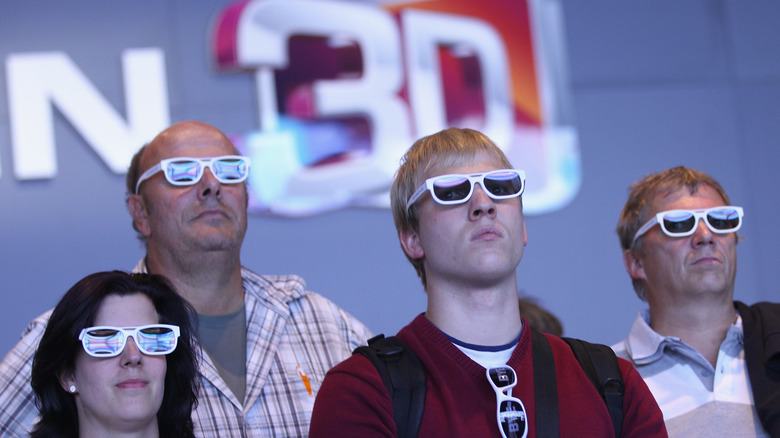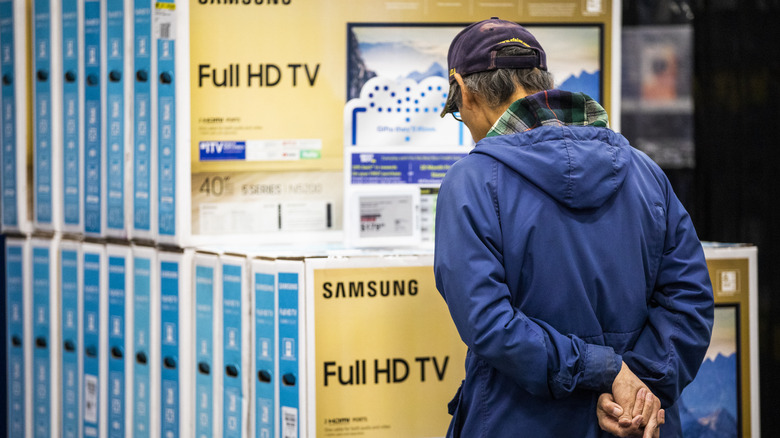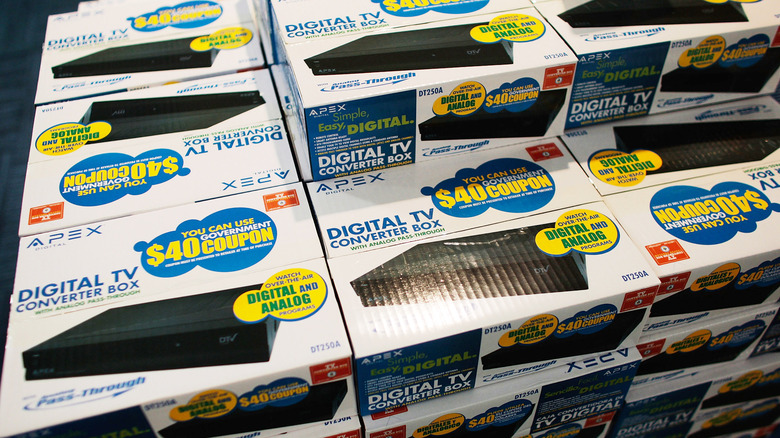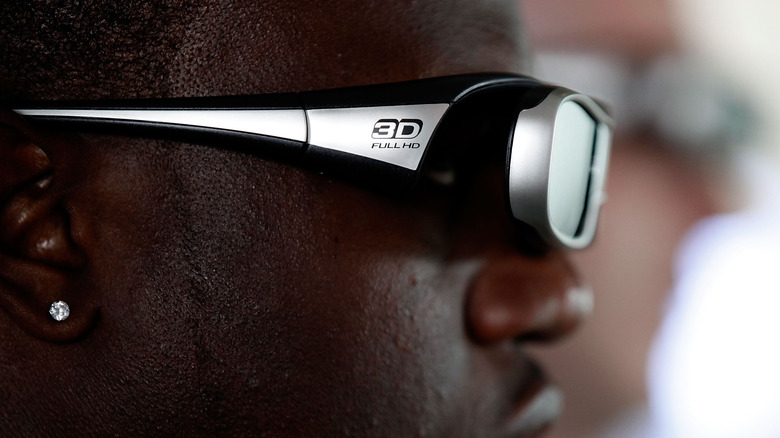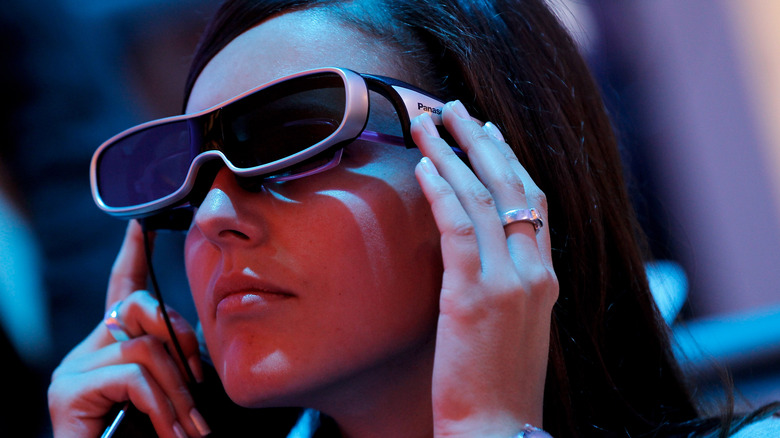The Rise And Fall Of 3D TVs
For a few years at the start of the 2010s, it seemed like 3D TVs were set to be the next big thing in consumer electronics. Every major TV manufacturer adopted the idea, and TV channels and DVDs were launched with 3D content ranging from movies to live sports events. But, fast forward to the second half of the decade, and 3D TV seemingly disappeared without a trace, replaced by panels touting 4K resolution and HDR. So what happened? Well, a mix of bad timing, practical limitations, and high costs were ultimately to blame for 3D TV's downfall.
The 3D TV was far from the only technology from the era that flopped as quickly as it launched — the Wii U was an even more notorious failure, with confusing marketing and a lack of games making it Nintendo's worst-selling console to date (aside from the Virtual Boy). The rate that both the Wii U and 3D TV were dropped served as a stark reminder to manufacturers that consumers wouldn't necessarily buy every new innovation the industry threw at them, no matter how hyped it was when it first launched. By 2016, most major manufacturers had stopped making TVs with 3D capabilities, and a year later, there were none on the market at all (via Museum of Failure). There's a chance that the format might make a comeback someday, with no-glasses 3D panels still under development. For now, though, the 3D TV is dead, barely making it a decade after it was launched in the first place.
Avatar Kickstarts the Trend
The idea of a three-dimensional television is not a new one. One of TV's earliest pioneers, John Logie Baird, first showed off an early form of 3D TV, called stereoscopic, in 1928 (via The Conversation). He spent years trying to convince broadcast executives and government committees to take on the idea, but he ultimately failed. TV bosses instead wanted to focus on improving the picture quality to give audiences crisper images, leaving Logie Baird's proposal on the sidelines. It took until the next century for 3D to score its first major hit, with the runaway success of 2009's "Avatar" at cinemas creating a wave of hype around the idea.
"Avatar" ended up becoming the highest-grossing movie of all time, and seeing its success, TV manufacturers quickly launched 3D-capable TVs to give consumers the same experience at home. LG and Panasonic were the first to launch 3D TVs, but every major manufacturer quickly followed (via Lifewire). Hot on their heels were the first 3D channels, with the likes of ESPN and Sky being some of the first to cater to this newly-emerging market. Home Blu-ray discs were also launched, so viewers could watch all their favorite movies in theater-style 3D at home.
A Temporary Sales Success
At first, everything seemed to be going well for the 3D TV. In 2011, 24 million 3D-capable TVs were sold globally, and by 2012, that figure had risen to over 41 million (via The Conversation). 3D features were often bundled in with high-end smart TVs, which was another up-and-coming feature at the time. This was great news for manufacturers, as it meant that more consumers were forced to buy top-end TVs to access all the latest tech, pushing up profit margins.
It was all looking good ... until it wasn't. Part of the issue with making smart TVs with 3D capabilities was that manufacturers didn't know whether viewers were buying their products for the smart functionalities, the 3D functionalities, or a mix of both. It would turn out that they appreciated the former much more than the latter, and the 3D content that was out there didn't gain as much traction as many broadcasters and studios expected it would.
Unfortunate Timing
One of the biggest issues affecting the adoption of 3D TV was the time it was introduced to the market. In 2009, the U.S. made the switch from analog TV to DTV, meaning that viewers either had to invest in a new digital TV to keep watching, or buy an analog-to-digital converter so their older TVs could receive the new format (via Lifewire). Having just shelled out for a new TV or converter, most consumers weren't ready to reach into their wallets again when 3D launched just a year later.
Although sales of 3D TVs were buoyed by an initial rush of hype, things quickly calmed down. Americans and consumers in many other countries across the globe were still feeling the effects of the 2008 recession, which had left many households having to tighten their purse strings and cut back on unnecessary purchases. While switching to DTV was very necessary for anyone who simply wanted to carry on watching TV, 3D couldn't have been less necessary, especially since the vast majority of content was still available in native 2D only.
Lack of 3D Content
That brings us to the next big issue with 3D TVs: There simply wasn't enough content to watch on them. Although a number of cable and satellite channels were launched immediately after the first 3D TVs made it to the market, most were axed just a year or two after. ESPN dropped its 3D offering in 2013, with Sky and other competitors exiting the market around the same time. Despite the organizers of the 2014 Sochi Winter Olympics committing to film every event in native 3D, actually viewing that content wasn't possible in most markets, as broadcasters refused to show it due to a lack of interest (via The Conversation).
With TV channels canceled, and sports games not shown in 3D even if it was available to broadcasters, a vicious cycle ensued. Fewer viewers were willing to engage with any remaining 3D content because there wasn't enough to keep them interested, and as a result, broadcasters and studios became more unwilling to produce 3D content. By 2016, the only new 3D content being released was movies, with one or two streaming services providing limited amounts of 3D shows on catchup.
Active vs. Passive Glasses
Content and timing aside, perhaps the biggest issue with 3D TV was that it couldn't be viewed by the naked eye. To get the 3D effect, viewers had to don glasses, and these came in two forms. Active glasses were used primarily by the likes of Samsung and Sony, and they featured shutters that rapidly opened and shut, alternating images between the left and right eye around 120 times per second (via TechRadar). They provided a more crisp 3D image than rival glasses, but they were battery-powered, making them heavy and often uncomfortable to wear. To make things even worse, one brand's active glasses weren't usually compatible with rival TVs, so someone with Samsung glasses couldn't watch 3D content on a Sony TV.
The other option for viewers was passive 3D glasses, which used simple polarized lens filters, much like the cinemas. They were the apparatus of choice for manufacturers like LG and Vizio, since they were lighter, cheaper, and compatible with different brands of TV. The main issue was that they cut image definition in half, leading to a much fuzzier picture which got worse as screen sizes increased. They also didn't help with eye strain, which was a common side effect for viewers with both active and passive glasses.
Hidden Expenses
While passive glasses could be picked up for just a few dollars, active 3D glasses often cost well over $100 a pair, and they could be easily broken (via Lifewire). For an average family of four who wanted to watch movies with a few friends, this was an extra expenditure that could add up to nearly the price of a new TV. Early active glasses also had a relatively short battery life, with some lasting only a few hours, barely enough to watch a movie.
Not only that, but viewers who wanted the optimal experience would have to ensure that their Blu-ray disc player, satellite or cable receiver, and any peripheral equipment was compatible with the 3D format. Unlike many TV innovations (like HDR and smart TVs) which fit seamlessly into a user's existing setup, making the most of a panel's 3D capabilities required a considerable effort, and most importantly, a lot of extra cash.
Image Quality Issues
Along with the annoyance of having to constantly wear TV glasses, viewers were also faced with a much lower image quality on 3D TVs than on their 2D counterparts. Viewing angle became a big factor, with the best 3D images only available when a viewer was sat looking directly at the screen. Move to the left or right a few feet, and the effect was often ruined. Room lighting could also cause problems, as 3D images were darker than their 2D counterparts, but TV manufacturers didn't increase their products' light output in response. This meant 3D TVs often appeared dim, even if they were able to show 2D content at a satisfactory brightness.
Even overlooking all of these issues, it's impossible to ignore the fact that some viewers simply didn't like watching 3D. Side effects like eye strain and nausea were so common that children and pre-teens were advised not to watch 3D TV at all, making watching movies as a family a very impractical affair (via TechRadar). Not to mention, anyone with only one eye or a lazy eye was unable to see the 3D effect, leaving them simply watching an out-of-focus screen.
Inadequate Retail Experiences
The final nail in 3D TV's coffin was that when it came to buying one, retailers were often woefully underprepared to persuade consumers to open their wallets. Lifewire reports that after the initial hype and demonstrations, retailers would often leave display TVs without batteries in the glasses, or missing the glasses altogether. Salespeople weren't properly informed about the benefits of a 3D TV, and some potential customers ended up walking out of the store unsure of how the TV even worked.
A common misconception was that 3D TVs couldn't display 2D content, and sales staff didn't do enough to dispel this myth, further putting off already-unsure customers. Especially with technology as hands-on as 3D, customers needed convincing of its appeal through real-world demonstrations, but all too often, those demonstrations simply weren't available in stores. In the end, would-be buyers simply chose a TV they could better understand the benefits of. Much like 3D TV channels, as there was less interest in the format, it became less worthwhile for retailers to properly train staff to show off the 3D TV's capability, starting a vicious cycle that led to a terminal disinterest from consumers.
The Death of 3D
With sales nosediving, 3D TV channels being axed, and a general unenthusiastic response from the public, TV manufacturers quickly lost interest in 3D as a format. It wasn't worth carrying on the development of a feature that almost no one was using, and so just as soon as they launched, 3D TVs were quietly removed from shelves. By 2017, all the big manufacturers had dropped 3D functionality, with LG's director of product development saying that, "it's just not a key buying factor when selecting a new TV," and that, "anecdotal information indicated [to us] that actual usage was not high" (via CNET). Instead, the company chose to focus on marketing 4K and HDR, which had a much more universal appeal.
With the big players all abandoning 3D, and the stream of new 3D content drying up, it seems like the format is gone forever. There are still a few movies that get a 3D release, but they're mostly 2D films that are converted to 3D after production. Most of those releases are on Blu-ray, and also come with a 2D version of the film included as standard, according to Lifewire. That's about it for new 3D content, though, and of course, watching any 3D film requires a compatible TV made before 2017. Most viewers will have upgraded their TVs since then, and with it, lost the ability to watch this now-novelty format.
Is a Revival in the Cards?
While it's very unlikely to make a return in the short term, there's a chance that 3D technology could make its way back into TVs in the future. Just before it discontinued them altogether, LG unveiled a 4K screen with passive 3D capabilities, which produced a much sharper image than the previous generation of 1080p screens ever could (via TechRadar). The technology could be fairly easily re-integrated into the current generation of 4K TVs at any time, without the need for expensive active glasses.
The original catalyst for the 3D craze in the first place was "Avatar," and creator James Cameron insisted that 3D wasn't dead, it was simply "accepted" (via Variety). The film's sequel, "Avatar: The Way of Water," will be released on December 16, 2022, in both 3D and 2D at cinemas. Whether this reinvigorates the demand for home 3D viewing remains to be seen, although it seems unlikely given that most of the pitfalls of the medium have yet to be convincingly solved. For now, 3D TV remains an innovative yet flawed idea that simply fell flat on its promises to revolutionize the TV world.
